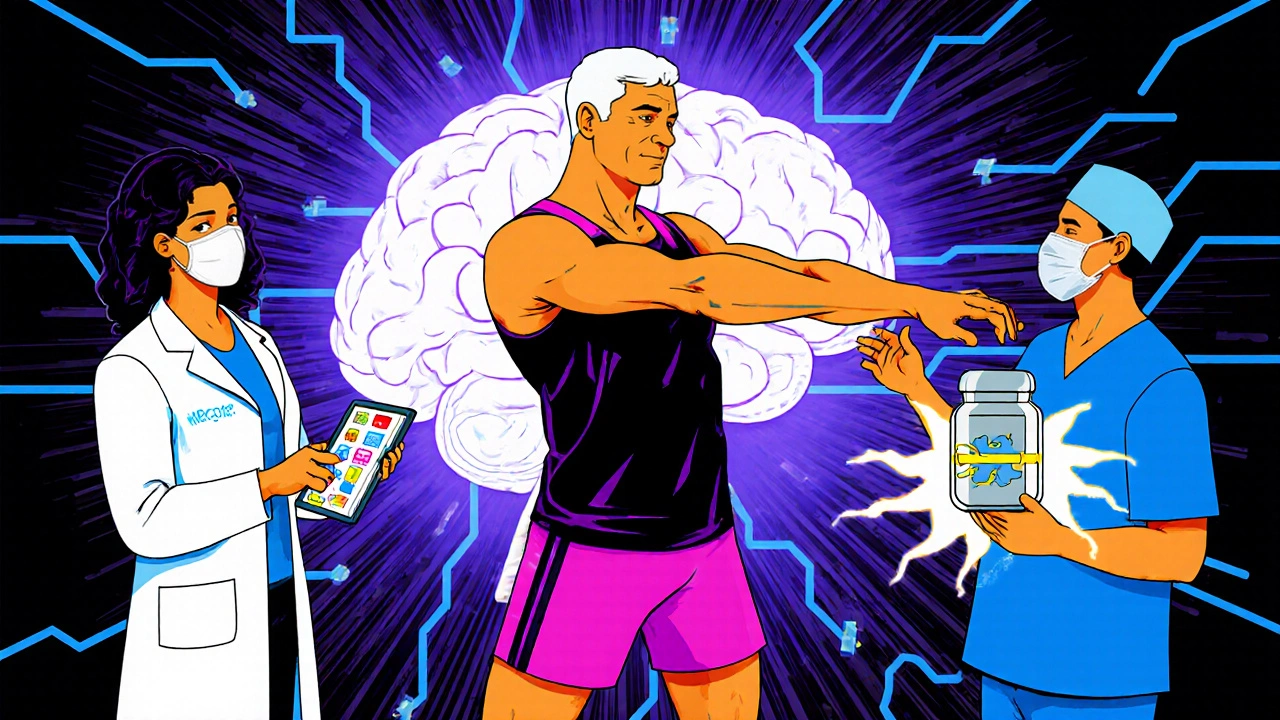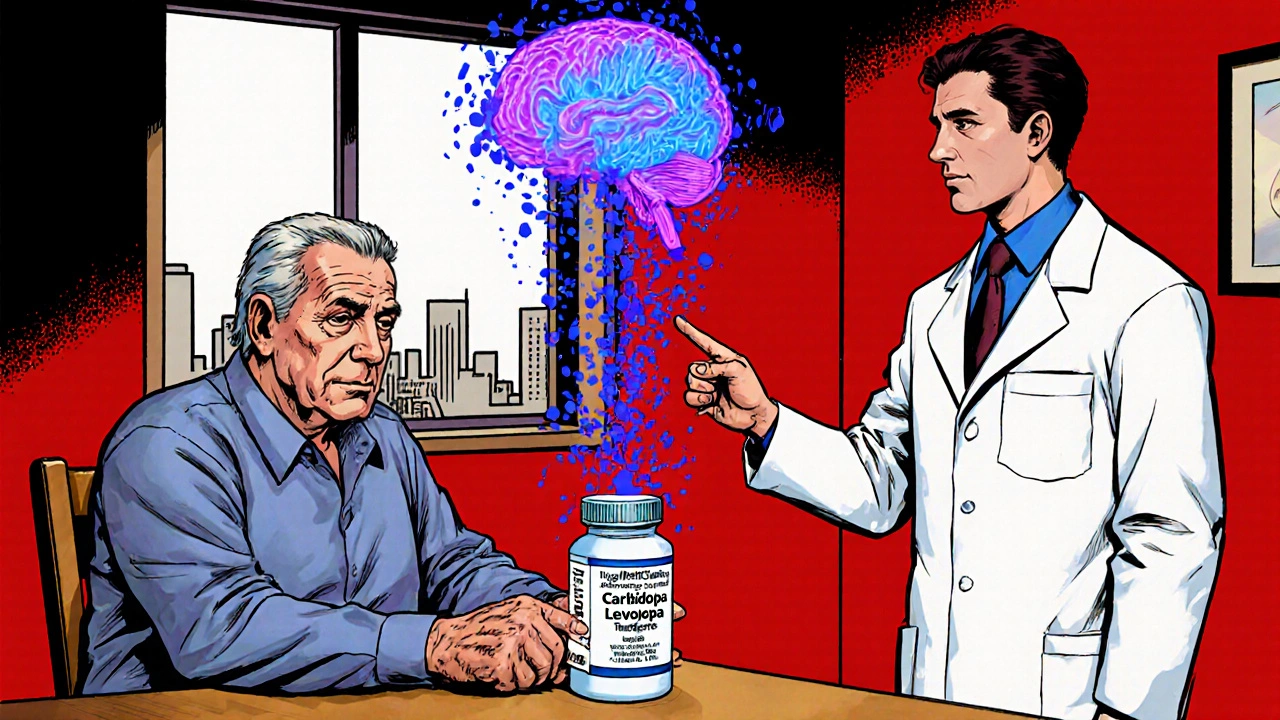When treating Parkinson’s disease, Carbidopa-Levodopa is a combination drug that boosts brain dopamine while preventing premature breakdown of levodopa. This guide explains what patients need to know, from how the medicine works to the range of alternative options.
Understanding carbidopa-levodopa is essential for anyone living with Parkinson’s disease.
Parkinson's disease is a progressive neurological disorder marked by tremor, rigidity, and slowed movement due to dopamine loss. Managing its symptoms often starts with Carbidopa-Levodopa, followed by a range of additional strategies.
Key Takeaways
- Carbidopa-Levodopa remains the first‑line treatment for most people with Parkinson’s disease.
- Common side effects include nausea, dizziness, and involuntary movements, but many can be managed.
- When symptoms start to fluctuate, clinicians may add dopamine agonists, MAO‑B inhibitors, or COMT inhibitors.
- Non‑pharmacologic therapies such as physiotherapy, exercise, and deep‑brain stimulation can improve quality of life and reduce medication load.
- Open communication with your neurologist is essential for tailoring the right regimen.
What is Carbidopa-Levodopa?
Levodopa is a precursor that the brain converts into dopamine, the neurotransmitter that dwindles in Parkinson’s disease. Carbidopa, on the other hand, blocks the enzyme dopa‑decarboxylase outside the brain, so more levodopa reaches the central nervous system. By pairing the two, the medication delivers a higher and more predictable dopamine boost with fewer peripheral side effects.
How Carbidopa-Levodopa Helps Parkinson’s Disease
Parkinson’s disease is characterized by the loss of dopamine‑producing neurons in the substantia nigra. The resulting dopamine deficit leads to motor symptoms such as tremor, stiffness, and slowness of movement. Carbidopa-Levodopa replenishes dopamine, temporarily restoring the brain’s ability to coordinate smooth movements.
Because levodopa is converted to dopamine only inside the brain, the drug can produce rapid symptom relief, often within 30‑60 minutes after a dose. This fast onset makes it especially valuable for managing “off” periods when symptoms flare up.
Typical Dosing and Administration
- Initial doses usually start low-often 25mg carbidopa with 100mg levodopa-to gauge tolerance.
- Doctors typically prescribe three to four doses per day, spaced evenly.
- Extended‑release (ER) formulations are available for patients who experience night‑time “off” periods.
- Take the medication with food if nausea occurs, but avoid high‑protein meals around dosing times, as protein can compete with levodopa for absorption.
- Never crush or chew tablets designed for controlled release; this can cause a dangerous surge of dopamine.
Benefits and Common Side Effects
Most patients experience a noticeable improvement in motor function within weeks. However, the drug is not without drawbacks. Common side effects include:
- Nausea or vomiting
- Dizziness or light‑headedness, especially when standing up quickly
- Dry mouth
- Loss of appetite
- Hallucinations or vivid dreams, particularly at higher doses
- Involuntary movements called dyskinesias, which often emerge after several years of therapy
Most side effects can be mitigated by adjusting the dose, timing, or adding adjunct medications.
When the Medication Starts to Wear Off
After several years, many patients notice that the same dose no longer provides full symptom control. This “wearing‑off” phenomenon occurs because the brain’s ability to store dopamine declines, making each dose shorter‑acting. Motor fluctuations can manifest as:
- Sudden “off” periods lasting minutes to hours
- On‑off swings where movement alternates between good and poor control
- Peak‑dose dyskinesias that appear at the height of levodopa concentration
These patterns signal that a treatment adjustment is needed, and they open the door to alternative therapies.
Alternative Pharmacologic Options
When Carbidopa-Levodopa alone isn’t enough, neurologists often add or substitute other drug classes. The most common alternatives include:
- Dopamine agonists are drugs that directly stimulate dopamine receptors in the brain (e.g., pramipexole, ropinirole) - stimulate dopamine receptors directly.
- MAO‑B inhibitors are medications that block the enzyme that breaks down dopamine (e.g., selegiline, rasagiline) - slow dopamine breakdown.
- COMT inhibitors are drugs that block the peripheral enzyme catechol‑O‑methyltransferase (e.g., entacapone, opicapone) - prolong levodopa effect.
- Anticholinergics (e.g., benztropine) - help control tremor but have cognitive side effects.
- Amantadine is an antiviral that also increases dopamine release and reduces dyskinesia - can lessen involuntary movements.
The choice depends on age, symptom profile, and tolerance. Below is a quick comparison.
| Drug Class | Typical Use | Key Benefit | Common Side Effects |
|---|---|---|---|
| Dopamine Agonists | Early to mid‑stage | Reduces “off” time, can delay levodopa start | Nausea, somnolence, impulse control disorders |
| MAO‑B Inhibitors | Adjunct to levodopa | Extends dopamine action, modest symptom control | Hypertension crisis with tyramine foods, insomnia |
| COMT Inhibitors | Adjunct for wearing‑off | Lengthens levodopa effect | Diarrhea, orange‑tinged urine |
| Anticholinergics | Predominant tremor | Improves tremor | Dry mouth, urinary retention, confusion |
| Amantadine | Dyskinesia management | Reduces involuntary movements | Liver toxicity, edema, livedo reticularis |

Non‑Pharmacologic Therapies
Medication alone rarely addresses all challenges of Parkinson’s disease. Complementary approaches can boost mobility, mood, and independence.
Deep Brain Stimulation is a surgical procedure that implants electrodes in specific brain regions to modulate abnormal activity. It’s typically considered when motor fluctuations persist despite optimal drug therapy.
Physiotherapy refers to targeted exercises that improve strength, balance, and gait. Regular sessions can delay the need for higher drug doses.
- Structured aerobic exercise (treadmill, cycling) supports cardiovascular health and may protect neurons.
- Resistance training strengthens muscles and reduces fall risk.
- Speech and swallowing therapy helps with communication and nutrition.
- Mind‑body practices such as tai chi or yoga improve flexibility and reduce anxiety.
Talking to Your Neurologist
Choosing the right mix of therapies is a collaborative process. Bring these questions to your appointment:
- What signs indicate that my current dose is no longer sufficient?
- Are there specific alternative drugs that match my symptom profile?
- What are the potential interactions with my other medicines?
- Would I be a candidate for deep‑brain stimulation or other advanced therapies?
- How can I incorporate exercise and diet changes safely?
Keeping a symptom diary for two weeks before the visit can help your doctor see patterns and adjust treatment more accurately.
Putting It All Together
Carbidopa-Levodopa remains the cornerstone of Parkinson’s disease management, but it’s rarely a forever‑only solution. Understanding its benefits, side effects, and the point at which it starts to wear off equips you to have an informed conversation with your healthcare team. Exploring dopamine agonists, MAO‑B inhibitors, COMT inhibitors, and non‑drug options such as deep‑brain stimulation or physiotherapy expands the toolbox for maintaining mobility and quality of life.
Remember, every patient’s journey is unique. Stay proactive, track changes, and never hesitate to ask for a medication review when you feel “off.” Your neurologist is there to tailor a plan that works for you.
Frequently Asked Questions
Can I take Carbidopa-Levodopa with food?
Yes, taking it with a light snack can reduce nausea, but avoid high‑protein meals right before dosing because protein may compete with levodopa for absorption.
How long does it take for the medication to start working?
Most people feel improvement within 30‑60 minutes after the first dose; the effect usually peaks around 90 minutes.
What are the early signs that I need a dose adjustment?
Increasing “off” periods, new dyskinesias, or feeling shaky shortly after a dose are signals to discuss a dosage change with your doctor.
Are dopamine agonists safer than Carbidopa-Levodopa?
They can delay the need for higher levodopa doses, but they carry their own risks like impulse‑control disorders and excessive sleepiness.
What is deep brain stimulation and who can get it?
Deep brain stimulation is a surgical option that delivers electrical pulses to specific brain areas. It’s generally offered to patients with significant motor fluctuations who respond well to levodopa but cannot achieve stable control with medication alone.


7 Comments
Steve Holmes
Wow, this guide really breaks down the basics of Carbidopa‑Levodopa, and it's super helpful!!! I love how it explains the dopamine boost clearly, and the side‑effect list is spot on, especially the nausea tip with food. Also, the dosage schedule makes sense for daily routines, and the reminder about protein interactions is gold. Keep these practical pointers coming!!!
Tom Green
Thanks for the kind words, Steve. It's great to see community members appreciating clear medical information; sharing knowledge helps everyone feel more confident managing Parkinson's. When discussing levodopa timing, remember that individual response can vary, so keeping a symptom diary is invaluable. Feel free to ask if you'd like more details on adjunct therapies.
James Falcone
Honestly, the US healthcare system could learn a thing or two from this-patients finally getting a straight‑up guide without the usual jargon overload. Carbidopa‑Levodopa is the real MVP, and we shouldn't let foreign regulations slow its use.
Valerie Vanderghote
The intricacies of Parkinson's treatment are a maze that many patients feel lost in, especially when navigating the sea of medication names and side‑effects, and this guide attempts to be a lighthouse, but I can't help but notice that it still leaves out the emotional toll of constantly adjusting doses, which can feel like a relentless rollercoaster that never truly ends, the frustration of morning "off" periods can bleed into personal relationships, causing spouses to feel neglected while you wrestle with tremors, and the endless appointments drain both time and finances, not to mention the anxiety that builds up each time you wonder if the next dose will trigger dyskinesias, while clinicians often focus solely on motor scores, ignoring the silent battles in the mind, this guide mentions physiotherapy, yet fails to address how access to qualified therapists can be a luxury for many, and the brief note on deep brain stimulation glosses over the emotional weight of deciding on brain surgery, I also wish there were more emphasis on community support groups, because isolation is a real danger, the mention of diet is useful, but the guidance could be richer with real‑world meal planning tips, let's not forget the caregiver's perspective-people who watch you struggle day after day, they deserve acknowledgment and resources too, in short, while the article is solid, it could be more compassionate, more holistic, and less clinical in tone.
Michael Dalrymple
Valerie raises several vital points that often go unaddressed in clinical overviews. A holistic approach that includes emotional well‑being, caregiver support, and access to therapy aligns with best practice guidelines. Incorporating community resources and detailed nutritional advice can indeed improve outcomes. Thank you for highlighting these gaps; they deserve further discussion.
RJ Samuel
Whoa, I get the whole "carbidopa‑levodopa is king," but tossing it aside for every new drug is like swapping a trusty steed for a shiny scooter that never lasts. Sometimes the old guard still rides the best.
Kate Marr
Levodopa rocks! 🚀